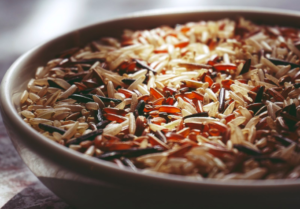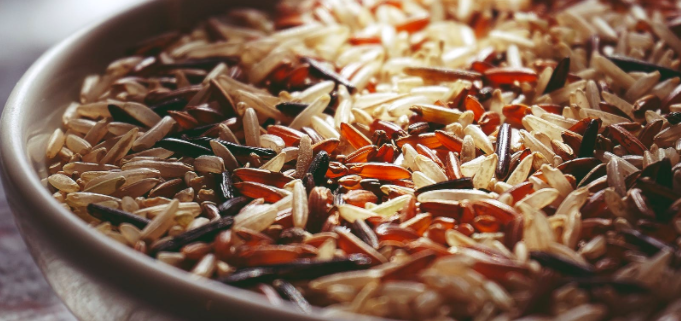Sugar, Spice, and Everything Rice: September is National Rice Month!
 What tiny, but mighty grain has captivated the hearts, and stomachs, of American’s for more than 300 years? That’s right, it’s rice! Rice is the oldest known food and is consumed by more than 3 billion people. There are more than 40,000 kinds of rice grown across the world that offer a variety of different tastes, textures and uses.
What tiny, but mighty grain has captivated the hearts, and stomachs, of American’s for more than 300 years? That’s right, it’s rice! Rice is the oldest known food and is consumed by more than 3 billion people. There are more than 40,000 kinds of rice grown across the world that offer a variety of different tastes, textures and uses.
During September, National Rice Month offers you the opportunity to learn more about the importance of rice, the many varieties of rice available, and to bring overall awareness to this nutritious and sustainable crop.
Now get your forks, palettes, and dinner tables ready to support your rice farmers and try all types of rice this month!
What exactly is rice?
Rice is a grain from the seed of the Monocot plant. There are two different species of the Monocot plant, which are the Oryza Sativa (Asian rice) or Oryza Glaberrima (African rice). From these species, there are more than 40,000 varieties of rice cultivated in the world. Rice can be categorized by length & shape, texture, color, and aroma.
Of the 40,000 varieties of rice, the following list is the most common types typically seen in our recipes, grocery stores, and even restaurants:
Length & Shape
- Long Grain Rice. Typically, around 7-9mm in length. When cooked, long grain rice remains separate and fluffy, which makes this kind of rice extremely versatile! Long-grain rice is commonly used in main courses, salads, and side dishes.
- Medium Grain Rice. Typically, around 5-6mm in length. Even after cooking, this rice has the ability to hold its shape and provides an enjoyable, smooth texture. With this in mind, medium-grain rice is a great choice when making risottos, pudding, and other desserts.
- Short Grain Rice. Typically, around 4-5mm in length. These fat, round grains have the highest starch content compared to the other types of rice previously mentioned. When cooked, short-grain rice gives a very sticky texture. This kind of texture is great for sushi, poke, and other Japanese-inspired dishes.
Texture
- Sticky Rice. Also known as “sweet rice”, sticky rice is commonly grown in Southeast and East Asia. When cooked, this rice becomes very sticky, moldable, and easy to create fun recipes with! Similar to other rice’s, sticky rice can be seen in both sweet and savory dishes. Traditionally, sticky rice is used in many Asian dishes, desserts, and other sweets.
- Parboiled Rice. This rough-looking rice, also more commonly known as “converted rice” or “easy-cook” rice, is very different from the rest. Parboiled rice simply means that it has been partially precooked before being packaged to eat. This ultimately allows for rice to be on your table or in your dishes much faster than other types of rice!
Color
- Brown Rice. This very popular and better-known rice offers a nutty flavor with great health benefits! Brown rice is a whole grain, which means it contains all parts of the grain– the bran, germ, and endosperm. With all of these parts still intact, this makes brown rice richer in fiber, vitamins, and minerals– all of which satisfy our stomachs and overall health.
- Black Rice. Also known as “forbidden rice”. This colorful rice has a high nutritional value with a mild nutty flavor. When cooked, black rice can be slightly sticky and moldable, which is very similar to the sticky rice previously mentioned. It is used in a variety of Chinese or Thai dishes, like Chinese black rice cakes and mango sticky rice. Try mixing black rice in with a rice pilaf or rice bowl to add a pop of color to your dishes!
- Polished Rice. Also known as “milled rice”. When rice is “polished”, this simply refers to white rice that has had its outer layers removed. This then reveals the rice’s vibrant, “polished”, white underlayer.
- Wild Rice. Typically harvested from the grass species Zizania, wild rice is high in protein and can definitely spice up any recipe! Wild rice adds color and an exotic twist to even the most bland-looking meals. Try incorporating wild rice in your next stir fry, soup, or casserole dish!
Aroma
- Basmati Rice. A type of long-grain rice that offers a subtle nutty or popcorn-like flavor and aroma. Basmati rice is popular among Indian cuisine and other ethnic dishes but can be used to add extra flavor to any recipe. Try serving basmati rice with fresh herbs, green onions, coconut or vegetables for a great pilaf!
- Jasmine Rice. This type of long-grain rice, also sometimes known as “Thai fragrant rice”, has a long kernel with a slightly sticky texture after cooking. Using Jasmine rice offers a subtle jasmine flavor and aroma into your dishes. Try cooking Jasmine rice alongside curry, stir-fry and other Thai and Asian-inspired dishes.
Quick and Easy Recipe Ideas
When strolling down the aisles of the grocery store, it can be very overwhelming when you are met with the thousands of different kinds of rice. Have no fear! Rice is extremely versatile and can be used at any time, in any recipe.
To help elevate some of the stresses of the dreaded rice aisle, here are some quick and easy recipe ideas:
- Jambalaya
- Mediterranean Chicken and Rice
- Rice Pudding
- Fried Rice or Stir Fry
- Warm Brown Rice Salad with Peas, Sundried Tomatoes, and Mint
- Risotto
- Stuffed Zucchini with Turkey, Brown Rice and Edamame
- Poke Bowls
- Rice Balls
There are many wonderful resources available to assist you in finding the perfect rice recipe, such as my most recent cookbook, Enjoying Food Peace: Recipes and Intuitive Eating Wisdom to Nourish Your Body and Mind, which you can purchase here if you haven’t already.
Celebrate National Rice Month this September by taking the time to learn, prepare and appreciate this tiny but mighty grain that has been a part of many cultures for centuries. Use the next 30 days of September for you and your family to discover as many varieties of rice as possible. Now, pull out the rice cooker and get to cooking!
Your Turn to Take Action: What new and interesting types of rice will you include into your daily dining this September? Let me know in the comments below.


Leave a Reply
Want to join the discussion?Feel free to contribute!